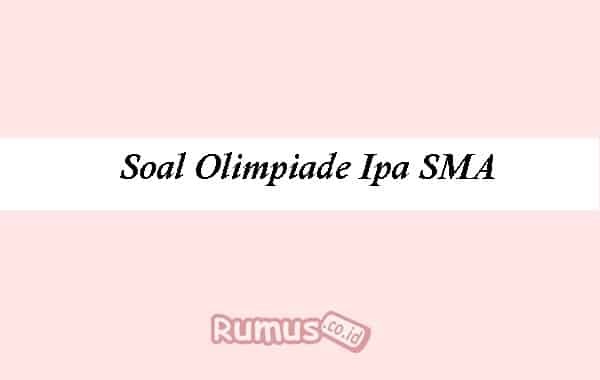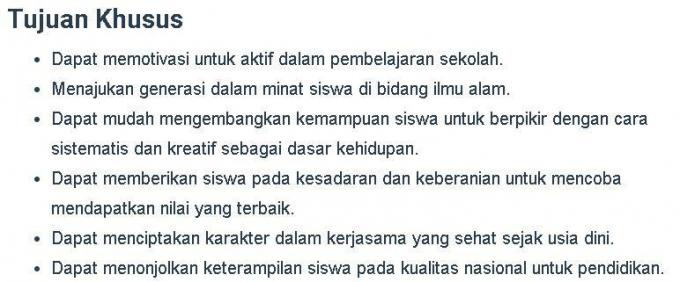About the 2021 National High School Science Olympiad & Discussion
hello buddy formula.co.id This time, we will discuss the National High School Science Olympiad Question Material – complete with the discussion, curriculum for the 2020-2021 school year, for high school level.
High School Science Olympiad questions – is the basic means to run the provincial national exam (OSN) and one of the science competitions which can make students take advantage of being ambassadors for competitions international.
When running the National Science Competition (KSN), students are expected to easily master science with technology in the field key areas and will be distributed to maximize the potential of talented students as creators in the Republic Indonesia.
Olympic competition is also a strategy to be able to improve the quality of education, so that it can hold a special position in various prestigious world-class events as international quality with mastery of science students.
Also Read: High School Math Olympiad Questions
Just take a look at the discussion below…?
High School Science Olympiad Practice Questions


Also Read: Elementary Mathematics Olympiad Questions
Example of high school Olympics
1. A student can use the work in a scientific method, by collecting data, the student will immediately.
a. Make observations
b. Set the hypothesis
c. Doing an experiment
d. Hypothesis testing
e. Conclusion drawing
2. The research which has the title “The effect of urea fertilizer on growth”, which is an independent variable is called.
a. Long time to plant corn
b. Corn Plant Growth
c. Amount of corn produced
d. Number of plants growing
e. Fertilizer content
3. Discharges resulting from industrial and domestic production processes, with their existence as a fixed point and in a place of no economic value, are considered.
a. Recycle
b. Pollution
c. Pollution
d. substance
e. Waste
4. Pay attention to the following data.
(1) Agricultural waste
(2) Solid waste
(3) exhaust gas
(4) household waste
The types of waste above based on the source are:
a. (1) and (2)
b. (1) and (3)
c. (1) and (4)
d. (2) and (3)
e. (2) and (4)
Also Read: Middle School Math Olympiad Questions
5. Waste made from the growth of living things in accordance with their habitat is.
a. Organic waste
b. inorganic waste
c. Liquid waste
d. Exhaust
e. Solid waste
6. Below is recycled plastic.
a. Plastic bottle- plastic bucket- plastic chair kursi
b. plastic bottle – styrofoam food bucket – bucket
c. Bucket – fan – glass bottle
d. Plastic chairs – plastic drinking containers – broken glass
e. Aluminum residue – water bottles – food containers
7. The path called quantitative data leads to.
a. Measure and kiss dan
b. Taste and hear
c. Weigh and measure
d. Touch and count
e. Weigh and taste
8. The branch of biology that deals with the causes of dengue fever is called.
a. Bacteriology
b. Virology
c. mycology
d. Cytology
e. Morphology
9. A student will seek information about the causes of TB, as the science that studies biology is called.
a. Bacteriology
b. Virology
c. mycology
d. Cytology
e. Morphology
10. The population density with the islands in Indonesia that is not balanced is .
a. Molecule
b. Cell
c. Network
d. population
e. Community
11. Materials that contain biotic components of the rice ecosystem are.
a. Rice, snake and mouse
b. Soil, water and sunshine
c. Buffalo, snake and light
d. Temperature, water and soil
e. Rice, mice, earth and water
Also Read: Example of Math Problems for Grade 1 Elementary School Semester 1
12. According to the field of medical biology, except.
a. IVF Program
b. Family planning method
c. Organ Transplant
d. Vaccine production
e. Plastic Surgery
13. Write the name with the correct species is.
a. MIMOSA PUDICA
b. Mimosa pudica
c. Mimosa pudica
d. Mimosa pudica
e. Mimosa pudica
14. Viruses at the level of organization of life are.
a. Molecule
b. Cell
c. Network
d. Organ
e. Organism
15. Viruses that can be considered as inanimate objects are.
a. Can be crystallized
b. Consists of protein
c. Can split
d. Only have DNA
e. Reproducing itself in living things
16. The viral envelope consists of.
a. Protein
b. fat
c. Carbohydrate
d. Vitamin
e. Mineral
17. Which is not a form of virus is.
a. trunk
b. Round
c. multivalent
d. Love the letter T.
e. spiral
18. Bacteriage is referred to as .
a. Bacteria that attack viruses
b. Viruses that attack bacteria
c. Pathogenic bacteria
d. Pathogenic virus
e. viral DNA
19. Attaching the tail fiber of the virus to the cell wall is a step.
a. Adsorption
b. penetration
c. ecliphase
d. maturation
e. Lyse
Also Read: Example of Math Problems for Grade 1 Elementary School Semester 2
20. In the cycle of viruses that control bacterial DNA is referred to as .
a. Capsid
b. DNA
c. Base plate
d. tail fiber
e. boss
21. Diseases associated with viruses include.
a. Measles, syphilis
b. TB, smallpox
c. typhoid, influenza
d. Malaria, DHF
e. Chikungunya, poliomyelitis
22. TMV is a virus that has.
a. Human immunity
b. tobacco leaf
c. Bacteria
d. Rice
e. Cat
23. F-16 as a speed of 2,520 km / h, according to.
a. 2.52 m/s
b. 700m/s
c. 420m/s
d. 1400m/s
e. 840 m/s
24. Instruments in measuring the mass of electrons are.
a. electronic micrometer
b. electron microscope
c. electronic balance
d. Electron ruler
e. mass spectrometer
25. The time to find the object in place by emitting an ultrasonic wave is 0.8 seconds, and if the speed there will be a propagation of sound in the air 340 m/s, as an object from a bat called.
a. 1,360 m
b. 13.60 m
c. 1,360 m
d. 136.0 m
e. 0.1360 m
26. The number of significant figures is 26,275 kg, of which 23.4 kg is.
a. 49,675 kg
b. 49.68 kg
c. 49.67 kg
d. 49.6 kg
e. 49.7 kg
Also Read: Examples of set problems and their solutions
27. Thickness can be measured by 0.00304 m, in the number of figures resulting from the measurement is.
a. 3
b. 4
c. 5
d. 6
e. 7
28. Among its sizes that are not vector sizes are called.
a. speed
b. mass
c. style
d. a change
e. acceleration
29. Two vectors that have dimensions of 6 units and 8 units, respectively, as the angles contained in the two vectors 900. and the resulting vector is .
a. 14 units
b. 16 units
c. 10 units
d. 20 units
e. 24 units
30. Vector A has 6 units and Vector B has 5 units then if the angle will be formed by the difference between the two vectors it is called as.
a. 45 units
b. 41 units
c. 30 units
d. 21 units
e. 11 units
Alright buddy, maybe that's all we can say about High School Science Olympiad questions ( high school), Hopefully what we have said above can be easily understood, thank you so much.
Also Read: About Middle School Science Olympiad
